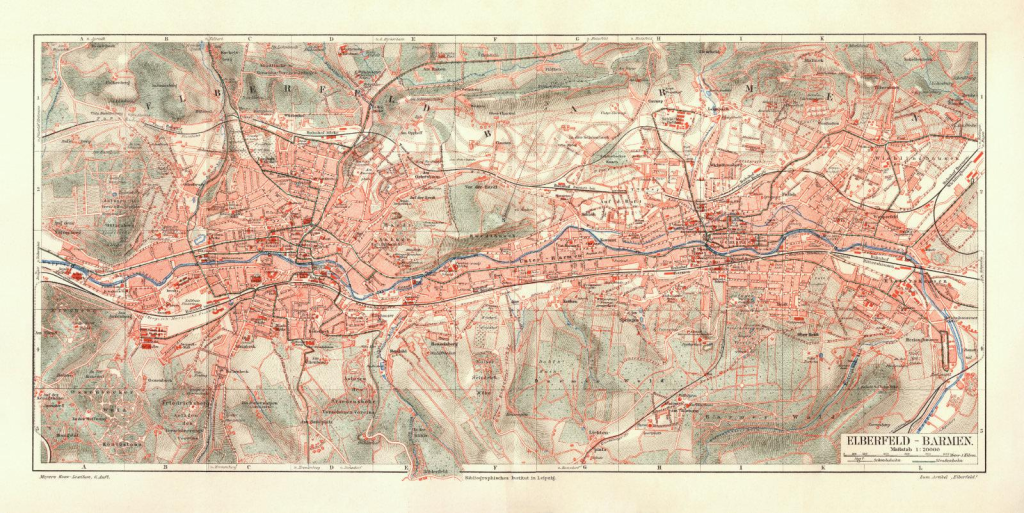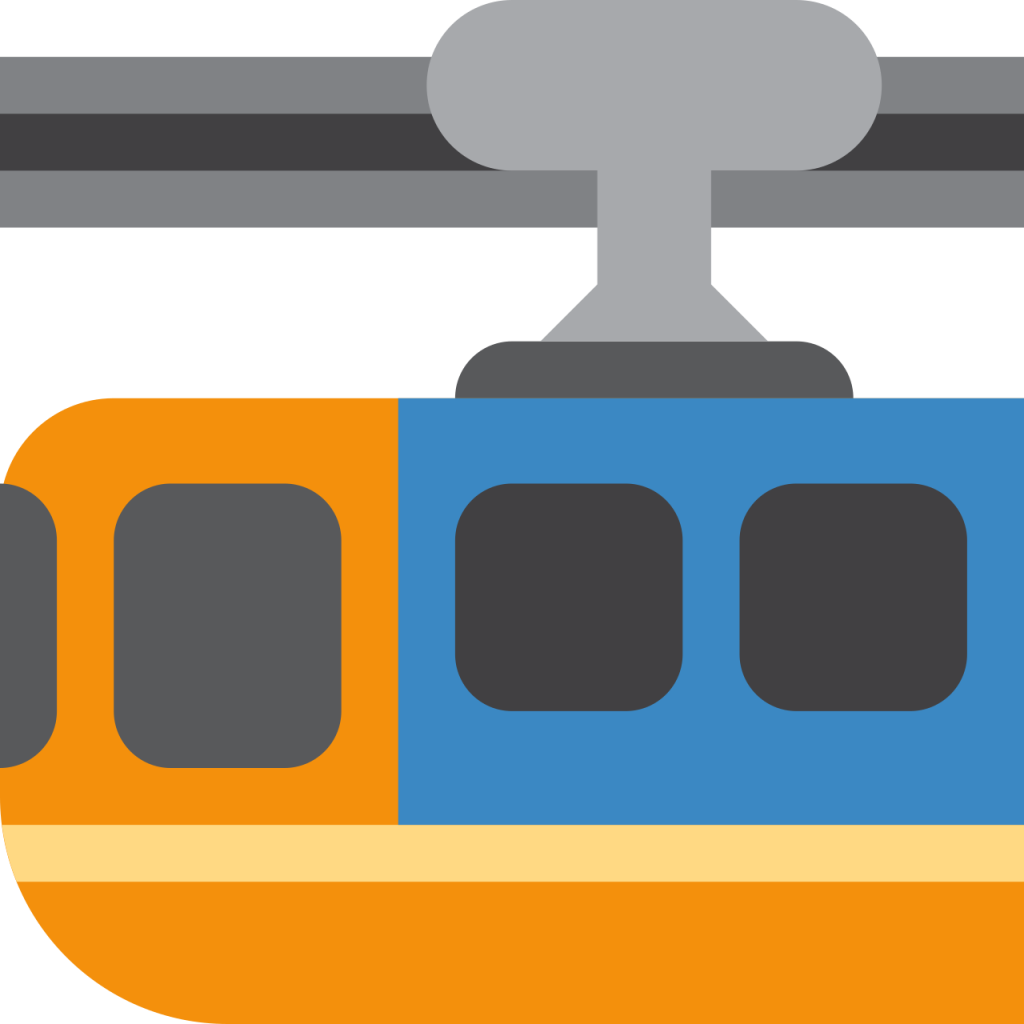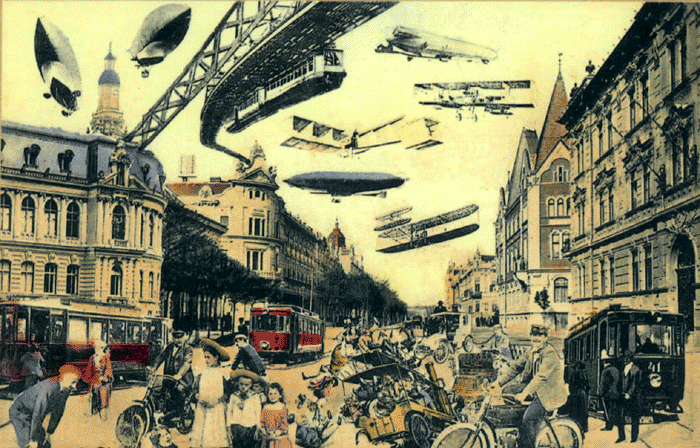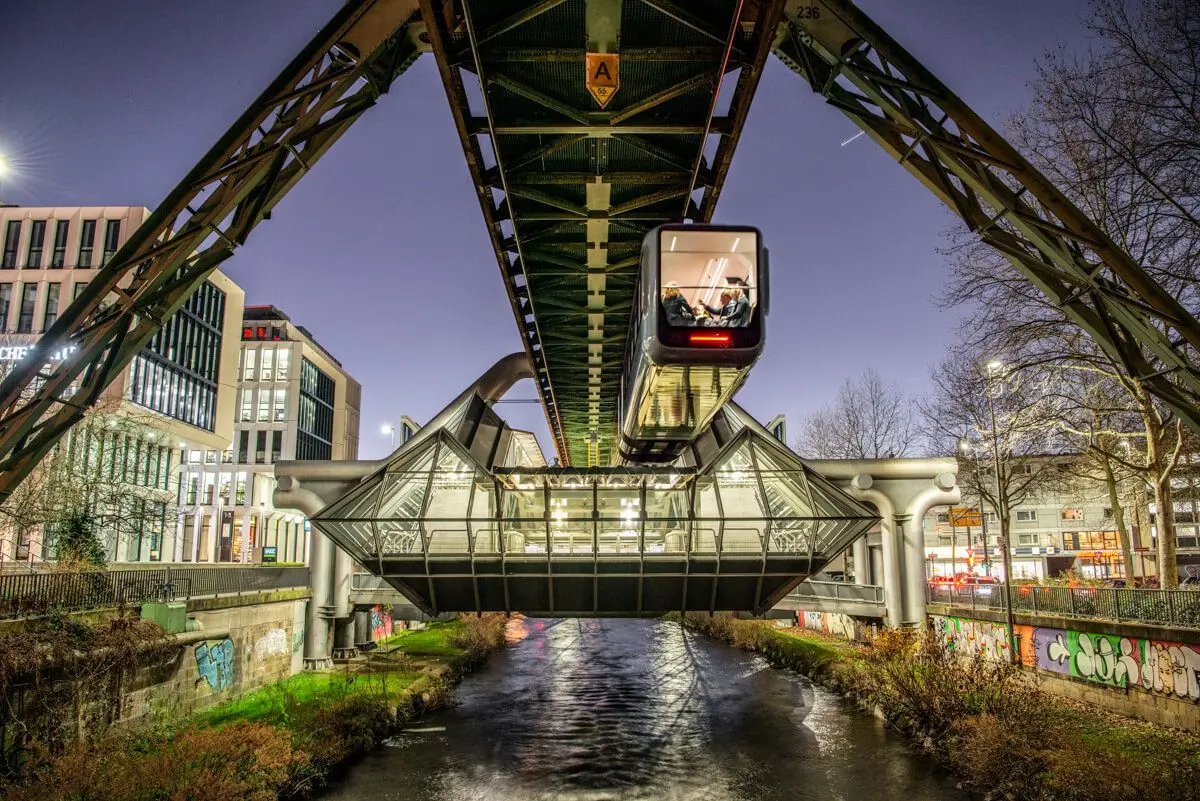The Wuppertaler Schwebebahn is a public transportation system in the city of Wuppertal, Germany. It has been connecting the city’s major destinations for more than a hundred years. Because of its ingenious design, it is loved by the people of Wuppertal as well as by visitors from all over the world.
How did such a marvelous piece of engineering develop in an otherwise little-known area of Germany, and not in the big cities of today? In this article, we examine the history of the Wuppertal suspension railway and the unique situation that led to its creation.
The Suspension Railway
When you visit Wuppertal, the most striking feature of this city is its unique urban transportation system. The “Wuppertaler Schwebebahn” travels through the city following the river Wupper. Not just following it, but gliding right over it. A ride on the Schwebebahn is a very different experience from the subways, trams and buses you know from other cities.

Getting on a Schwebebahn train can be a bit scary at first. After all, the stations are all high above the ground. However, the stations are constructed in such a way that no one can fall to the ground. Once you get over your initial skepticism about getting on a train that seems to be floating above the ground, you feel right at home again, just like in a tram. Then the ride begins and you leave the confines of a station. Now there is no longer any safe ground below you, only the blue Wupper river. As the train follows the river’s meanderings through the bustling city, you enjoy an unobstructed view of the cityscape and the blue ribbon below. When the train takes a turn, you will not feel your body pressing against the walls or your neighbor. Instead, the train itself moves, following the centrifugal force as it swings into the curve.

Because it is such a surprising experience, many tourists like to travel the entire length of the single line of the suspension railway, a trip that takes them 30 minutes and covers 13.3 km.
Tourists are fascinated by this train, while the people of Wuppertal use it every day to get to work, school or the city center.
Tourists and locals alike love the gliding train. But why is it only in Wuppertal, a city on the edge of the Ruhr area? How did it develop? The answer lies in Wuppertal’s very special situation.
A Special Situation
Let’s go back to the 19th century. It was the time when the Industrial Revolution began in Germany. Two towns along the Wupper River developed into early industrial centers: Barmen and Elberfeld. The factors that favored the growth of these cities were the availability of iron ore, coal, wood, and water power. In addition, the region had many entrepreneurs who were constantly looking for new ways of production. All of these points combined caused the Industrial Revolution to start in these two cities well ahead of other regions in Germany, even the later much more famous Ruhr area. This growth naturally led to more jobs. People were attracted to the cities, causing them to grow.
The Wupper River flows through the hills of the “Bergisches Land”, a very hilly area in the western part of Germany. The hills on both sides of the river limited the growth of the cities of Barmen and Elberfeld. They soon occupied most of the flat land between the cities and eventually touched each other. The conglomerate of these two cities later merged into one, which is now called the city of Wuppertal (“valley of the Wupper”).

The growth of these two cities occurred very quickly and very early in the Industrial Revolution. At that time, urban transportation systems as we know them today, such as subways or elevated railways, had not yet been developed. This fact and the uncontrolled growth meant that there was no room for a transport system in the Wupper valley.
The cities of Elberfeld and Barmen eventually adopted a tramway system, but it was also limited by space, resulting in inefficient one-way lines in some places.
However, the population of both cities continued to grow, so a solution had to be found.
That solution came in the form of the industrious engineer Eugen Langen from Cologne. Eugen Langen was a successful entrepreneur who made his money by developing and industrializing the Ottomotor. He also owned a factory that manufactured railroad cars. In this factory he developed a prototype of a suspension railway.

When the city councils of Barmen and Elberfeld were looking for a solution for their transporation system, they decided to give the “System Langen” a go, even though there was no practical experience with this system. In a big leap of faith, they decided to buy this untested system because it was especially suited to their situation.
The new system used the only open space available in the urban area: The air above the Wupper River. The river winds through the city, but the new system could easily follow all the curves the river takes. The fact that the trains could lean into the curves without discomfort to the passengers meant that they could achieve relatively high speeds in the absence of long stretches of straight track.
Another factor in favor of the new system was that the city only needed one line. Monorails suffer from the problem that it is very difficult to build turnouts, and thus complex networks with several lines could hardly be built with the technology of the day. But the city fathers of Barmen and Elberfeld only needed one line, since the topography of their cities limited their growth anyway.
Once the decision was made, construction began in 1898. And just three years later, in 1901, the first section was opened. It was a marvelous feat of engineering, considering that it was a completely new and untested system that had to be built on the fly in a densely populated city, and many difficult problems arose as construction progressed.
At the time of its opening, both the public and the engineers were impressed, and they remain so to this day.
It even has its own emoji on Twitter:

Why is there only one Schwebebahn?
The “System Langen” proved to be very effective in Wuppertal. But after that, only one other line was built with this system, a short section of an aerial tramway on a mountain in Dresden. Many decades later, a short suspension railway was opened in Dortmund (“H-Bahn”), but it does not carry as many passengers as the one in Wuppertal.

Why has this system not been adopted by other cities? After all, at the time the suspension railway was built, it was included in futuristic visions of cities in the new century:

My guess is that such a system is very expensive to build and operate, and this deters potentially interested cities. The construction of the rails and supporting beams of the Wuppertal suspension railway had to be planned very precisely, and each piece was unique. No standardization was possible, which makes construction very difficult. Cities with less challenging topography might find it easier to use normal railroad or tramway tracks instead.
Another factor, which I mentioned earlier, is that it is difficult for a monorail system to develop into a complex network due to the problems of building turnouts. In cities where a network is needed to serve all parts of the population, such a monorail will have a major disadvantage. However, this problem has been mitigated in recent years by the construction of more efficient turnouts (Link).
A train gliding high above the ground will also be a major privacy concern if it is not following a river, but running through the streets of a densely populated urban area. People in nearby houses might feel they were being watched by the suspension railway’s passengers. This point is illustrated by the Wuppertal suspension railway itself, because a short section of it had to be built along a street. The city had to pay the neighbors of the new street to buy new curtains so that the neighbors could shield themselves from the view of the passengers.
Conclusion
I hope you have enjoyed this excursion into the history of one of the world’s most fascinating public transport systems. We have seen how a very special situation, combined with the enterprising spirit of the time, could lead to a very unique solution and a feat of engineering that is still unrivaled a hundred years later. Although this system was not widely adopted, there are many lessons to be learned from the story of the Wuppertal suspension railway.

3 replies on “The Wuppertal Suspension Railway – An Ingenious Solution to a Unique Transportation Problem”
[…] One of the better-known monorials is the Wuppertal suspension railway, which I wrote about a few months ago. Or maybe you know the “Alweg Monorail”. If you have been to the Disneyland amusement […]
[…] Ottobahn is an elevated railway system, like the Wuppertal Suspension Railway. What is new about it is that it does not carry entire trains, but smaller capsules or […]
[…] run on elevated tracks. So does the famous suspension Railway in Wuppertal (which I presented in another article). So, in principle, there should be little resistance to another mode of transportation running […]